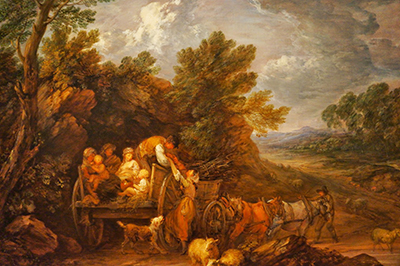The Harvest Wagon is the name given to Thomas Gainsborough's paintings; one in 1767 and the other done 17 years later. The latter was an improvement of the former with colouring and precision factored. Of the two artworks, the 1784 one is the most visible. Born and bred at the time the West was undergoing the industrial and agricultural revolution, his paintings show his mastery in landscape drawing.
In this article, we will focus on the latter painting, as it is widely recognised of the two. The drawing is done on canvas using oil; a popular method at the time. Originally done on a 48 by 59 inches, it shows a group of people riding on a wagon in a typical rural setting. It is believed that the location was Bath, a town in Somerset – West of London where he grew up. It shows a man trying to help a woman onto the wagon. There is also a young man leading the wagon as some sheep graze nearby.
Comparing the two paintings, both have the same setting and design, but the light effects, clarity and influence are different. This is a clear growth curve of how Gainsborough had undergone in 17 years. The analysis of the two painting shows the precision of character and details in the second painting and more relaxed figures. The first picture was acquired by the Barber Institute of Fine Arts, located in Birmingham, United Kingdom. The second painting was bought by Frank Wood, a Canadian Philanthropist who later donated it to the Art Gallery of Ontario.
Some of Gainsborough's work included portraits of prominent people like Ignatius Sancho (1768), Sir Robert Clayton (1769), Carl Friedrich Abel (1765), James Christie (18), Mrs Sarah Siddons (1785) amongst others. He also did a painting of Girl with Pigs (1781-2), The Morning Walk (1785) and numerous landscape paintings. He is described as the most technically proficient artist of his time by Michael Rosenthal. He mostly painted nature and its influence on humanity. His style has since been adopted by his nephew Gainsborough Dupont and John Hoppner. He is credited among other pioneers, as the originator of the 18th Century British Landscape School.




